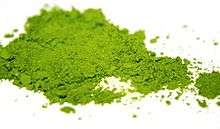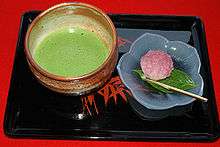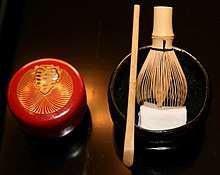Matcha
| Matcha | |
|---|---|
 | |
| Type | Green tea |
|
| |
| Other names | 抹茶, "fine powder tea" |
| Origin | China |
|
| |
| Quick description | Stone-ground Japanese-style green tea |
|
| |
| Regional names | |||||||||||||||
|
"Matcha" in kanji | |||||||||||||||
| Chinese name | |||||||||||||||
|---|---|---|---|---|---|---|---|---|---|---|---|---|---|---|---|
| Chinese | 抹茶 | ||||||||||||||
| |||||||||||||||
| Korean name | |||||||||||||||
| Hangul | 말차 | ||||||||||||||
| Hanja | 末茶 | ||||||||||||||
| |||||||||||||||
| Japanese name | |||||||||||||||
| Kanji | 抹茶 | ||||||||||||||
| Kana | まっちゃ | ||||||||||||||
| |||||||||||||||
Matcha (抹茶, Japanese pronunciation pronounced [mat.tɕa], English /ˈmætʃə/[1][lower-roman 1]) is finely ground powder of specially grown and processed green tea leaves. It is special in two aspects of farming and processing: the green tea plants for matcha are shade-grown for about three weeks before harvest and the stems and veins are removed in processing. During shaded growth, the plant Camellia sinensis produces more theanine and caffeine. The powdered form of matcha is consumed differently from tea leaves or tea bags, and is dissolved in a liquid, typically water or milk.
The traditional Japanese tea ceremony centers on the preparation, serving, and drinking of matcha as hot tea and embodies a meditative spiritual style. In modern times, matcha has also come to be used to flavor and dye foods such as mochi and soba noodles, green tea ice cream, matcha lattes, and a variety of Japanese wagashi confectionery. Matcha used in ceremonies is referred to as ceremonial-grade matcha, meaning that the matcha powder is of a high enough quality to be used in the tea ceremony. Lower quality matcha is referred to as culinary-grade matcha, but there is no standard industry definition or requirements for either.
Blends of matcha are given poetic names known as chamei ("tea names") either by the producing plantation, shop, or creator of the blend, or by the grand master of a particular tea tradition. When a blend is named by the grand master of a tea ceremony lineage, it becomes known as the master's konomi.
History

In China during the Tang Dynasty (618–907), tea leaves were steamed and formed into tea bricks for storage and trade. The tea was prepared by roasting and pulverizing the tea, and decocting the resulting tea powder in hot water, then adding salt.[2] During the Song Dynasty (960–1279), the method of making powdered tea from steam-prepared dried tea leaves, and preparing the beverage by whipping the tea powder and hot water together in a bowl became popular.[3]
Preparation and consumption of powdered tea was formed into a ritual by Chan or Zen Buddhists. The earliest extant Chan monastic code, entitled Chanyuan Qinggui (Rules of Purity for the Chan Monastery, 1103), describes in detail the etiquette for tea ceremonies.[3][4]
Zen Buddhism and the Chinese methods of preparing powdered tea were brought to Japan in 1191 by the monk Eisai. In Japan it became an important item at Zen monasteries and from the fourteenth through to the sixteenth centuries was highly appreciated by members of the upper echelons of society. Although powdered tea has not been popular in China for some time, there is now a global resurgence in the consumption of Matcha tea, including in China.
Production
Matcha is made from shade-grown tea leaves that also are used to make gyokuro. The preparation of matcha starts several weeks before harvest and may last up to 20 days, when the tea bushes are covered to prevent direct sunlight.[5] This slows down growth, stimulates an increase in chlorophyll levels, turns the leaves a darker shade of green, and causes the production of amino acids, in particular theanine. Only the finest tea buds are hand-picked. After harvesting, if the leaves are rolled up before drying as in the production of sencha, the result will be gyokuro (jade dew) tea. If the leaves are laid out flat to dry, however, they will crumble somewhat and become known as tencha (碾茶). Then, tencha may be de-veined, de-stemmed, and stone-ground to the fine, bright green, talc-like powder known as matcha.[6]
Grinding the leaves is a slow process, because the mill stones must not get too warm, lest the aroma of the leaves is altered. It may take up to one hour to grind 30 grams of matcha [7]
The flavour of matcha is dominated by its amino acids.[8] The highest grades of matcha have more intense sweetness and deeper flavour than the standard or coarser grades of tea harvested later in the year.[9]
Grades
Matcha can be categorised into three grades:
- Ceremonial grade: This is the highest quality used mainly in tea ceremonies and Buddhist temples. This is stone-ground into a powder by granite stone mills. It is high-quality and expensive (~$100–140 for 100g). The unschooled drinker is unlikely to notice a large difference between Ceremonial and Premium grade. Ceremonial is characterized by subtle tones of "umami".
- Premium grade: High-quality matcha green tea that contains the full nutritional content and uses tea leaves from the top of the tea plant. Price point (~$50–80 for 100g). Best for daily consumption and contains the full range of antioxidants, vitamins and minerals. Is characterized by a fresh, subtle flavour. Usually perfect for both new and everyday matcha drinkers alike.
- Cooking/culinary grade: Cheapest of all (~$15–40 for 100g). Suitable for cooking purposes. Slightly bitter due to using leaves lower down on the green tea plant.
In general, matcha is expensive compared to other forms of tea, although its price depends on its quality. Grades of matcha are defined by many factors.
Location on the tea bush
Where leaves destined for tencha are picked on the tea bush (Camellia sinensis) is vital.
The very top should have developing leaves that are soft and supple. This gives a finer texture to higher grades of matcha. More-developed leaves are harder, giving lower grades a sandy texture. The better flavour is a result of the plant sending the majority of its nutrients to the growing leaves.
Treatment before processing
Traditionally, sencha leaves are dried outside in the shade and never are exposed to direct sunlight; however, now drying mostly has moved indoors. Quality matcha is vibrantly green also as a result of this treatment.[10]
Stone grinding
Without the correct equipment and technique, matcha can become "burnt" and suffer degraded quality. Typically in Japan matcha is stone-ground to a fine powder through the use of specially designed granite stone mills.[10]
Oxidation
Oxidation is also a factor in determining grade. Matcha exposed to oxygen may easily become compromised. Oxidized matcha has a distinctive hay-like smell and a dull brownish-green colour.
Traditional preparation

There are two main ways of preparing matcha: thick (濃茶 koicha) and thin (薄茶 usucha).
Prior to use, the matcha often is forced through a sieve in order to break up clumps. There are special sieves available for this purpose, which usually are stainless steel and combine a fine wire mesh sieve and a temporary storage container. A special wooden spatula is used to force the tea through the sieve, or a small, smooth stone may be placed on top of the sieve and the device shaken gently.
If the sieved matcha is to be served at a Japanese tea ceremony, then it will be placed into a small tea caddy known as a chaki. Otherwise, it can be scooped directly from the sieve into a tea bowl.
About two to four grams of matcha is placed into the bowl, traditionally using a bamboo scoop called a chashaku, and then about 60-80 ml of hot (70–85 °C or 158–185 °F, not boiling,[11]) water is added. The mixture is then whisked to a uniform consistency, using a bamboo whisk known as a chasen. There must be no lumps left in the liquid, and no ground tea should remain on the sides of the bowl. Because matcha may be bitter, it is traditionally served with a small wagashi sweet[12] (intended to be consumed before drinking), but without added milk or sugar. It usually is considered that 40 g of matcha will provide for 20 bowls of usucha or 10 bowls of koicha:[13]
Usucha, or thin tea, is prepared with approximately 1.75 grams (amounting to 1.5 heaping chashaku scoop, or about half a teaspoon) of matcha and approximately 75 ml (2.5 oz) of hot water per serving, which can be whisked to produce froth or not, according to the drinker's preference (or to the traditions of the particular school of tea). Usucha creates a lighter and slightly more bitter tea.
Koicha, or thick tea, requires significantly more matcha (usually about doubling the powder and halving the water): approximately 3.75 grams (amounting to 3 heaping chashaku scoops, or about one teaspoon) of matcha and approximately 40 ml (1.3 oz) of hot water per serving, or as many as six teaspoons to 3/4 cup of water. Because the resulting mixture is significantly thicker (with a similar consistency to liquid honey), blending it requires a slower, stirring motion that does not produce foam. Koicha is normally made with more expensive matcha from older tea trees (exceeding thirty years) and, thus, produces a milder and sweeter tea than usucha; it is served almost exclusively as part of Japanese tea ceremonies.
Other uses
It is used in castella, manjū, and monaka; as a topping for shaved ice (kakigōri); mixed with milk and sugar as a drink; and mixed with salt and used to flavour tempura in a mixture known as matcha-jio. It is also used as flavouring in many Western-style chocolates, candy, and desserts, such as cakes and pastries (including Swiss rolls and cheesecake), cookies, pudding, mousse, and green tea ice cream. Matcha frozen yogurt is sold in shops and can be made at home using Greek yogurt. The Japanese snack Pocky has a matcha-flavoured version. Matcha may also be mixed into other forms of tea. For example, it is added to genmaicha to form what is called matcha-iri genmaicha (literally, roasted brown rice and green tea with added matcha).
The use of matcha in modern drinks has also spread to North American cafés, such as Starbucks, which introduced "Green Tea Lattes" and other matcha-flavoured drinks after matcha became successful in their Japanese store locations. As in Japan, it has become integrated into lattes, iced drinks, milkshakes, and smoothies.[14] A number of cafes have introduced lattes and iced drinks using matcha powder. It has also been incorporated into alcoholic beverages such as liqueurs and matcha green tea beers.
- Matcha ice cream
 Matcha cake
Matcha cake Matcha cupcake with pistachio
Matcha cupcake with pistachio
Basic matcha teaware

The equipment required for the making of matcha are:
- Tea bowl (茶碗 chawan)
- Large enough to whisk the fine powder tea around 120 millilitres (4.06 US fl oz)
- Tea whisk (茶筅 chasen)
- A bamboo whisk with fine bristles to whisk or whip the tea foam
- Tea spoon (茶杓 chashaku, also called tea scoop)
- A bamboo spoon to measure the powder tea into the tea bowl. Not the same as a Western teaspoon.
- Tea caddy (棗 natsume)
- A container for the matcha powder tea
- Tea cloth (茶巾 chakin)
- A small cotton cloth for cleaning tea ware during the tea ceremony
See also
Notes
- ↑ "Matcha", also called fine powder tea or powdered tea, is the most common spelling, and accords with Hepburn romanization of the hiragana まっちゃ. In Kunrei-shiki romanization (ISO 3602) it is "mattya". "Maccha" is a nonstandard and uncommon spelling.
References
- ↑ "matcha - Definition of matcha in English by Oxford Dictionaries". Oxford Dictionaries - English. Retrieved 9 September 2017.
- ↑ Han Wei, "Tang Dynasty Tea Utensils and Tea Culture: Recent Discoveries at Famen Temple," in Chanoyu Quarterly no. 74 (1993)
- 1 2 Tsutsui Hiroichi, "Tea-drinking Customs in Japan," paper in Seminar Papers: The 4th International Tea Culture Festival. Korean Tea Culture Association, 1996.
- ↑ "thezensite: The Origins of Buddhist Monastic Codes in China; book review". thezensite.
- ↑ "A Matcha Highlight Part One: Harvesting Grade A Matcha". 1 June 2012. Retrieved 9 September 2017.
- ↑ "How Matcha is Processed". Ippodo Tea. Retrieved 19 September 2012.
- ↑ "How Matcha Green Tea is Produced". www.breakawaymatcha.com. Retrieved 9 September 2017.
- ↑ Kaneko, Shu; Kumazawa, Kenji; Masuda, Hideki; Henze, Andrea; Hofmann, Thomas (March 2006). "Molecular and Sensory Studies on the Umami Taste of Japanese Green Tea". J. Agric. Food Chem. 54 (7): 2688–2694. doi:10.1021/jf0525232. PMID 16569062.
- ↑ "Aiya's Blog - The Different Grades of Matcha (and Their Characteristics)". www.aiya-america.com. Retrieved 9 September 2017.
- 1 2 "Growing and Processing of Matcha". Marukyu-Koyamaen. Retrieved 18 April 2016.
- ↑ "Preparation of Matcha". Marukyu-Koyamaen.
- ↑ Hosking, Richard (1997). "Wagashi". A Dictionary of Japanese Food. Tuttle Publishing. p. 168.
- ↑ Horaido. "H4". JP: Dion. Archived from the original on 2005-04-06.
Matcha used to be sold in packages of 10 monme (ancient measure of about 3.75 g, or 37.5 g for the package) and most tea masters considered that one package provided for 20 usucha (about 1.8 g each) or 10 koicha (about 3.75 g each). This is why today's traditional packaging is 40 g (the closest to 10 monme)
- ↑ "Matcha Green Tea Smoothie". Living Fresh Daily Recipes. 2018-03-07.
External links
